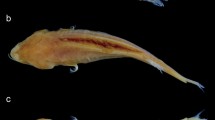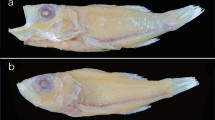Abstract
The pygmygoby Trimma albicaudatum sp. nov. is described on the basis of a single specimen (18.0 mm standard length) from Sagami Bay, Honshu, Japan. The new species can be distinguished from all congeners by the following combination of characters: VI-I, 9 dorsal-fin rays, no elongate spines on first dorsal fin; I, 8 anal-fin rays; 18 pectoral-fin rays, all unbranched; 8.5 anterior transverse scales; 7 cycloid scales along predorsal midline; fifth segmented ray of pelvic fin unbranched, its length less than half of fourth ray (viz., 43.2%); pelvic frenum absent; interorbital groove shallow; interorbital width less than half pupil diameter (viz., 46.3%); cheek without scales; sensory papillae row c comprising 6 papillae; opercle with two embedded cycloid scales dorsally; ground color of body yellow when freshly collected (greenish in life); snout, tip of lower jaw, interorbital space, and upper and lower parts of iris violet when fresh and in life; a dorsoventral pair of pink blotches on caudal peduncle when freshly collected (white in life); dorsoventral margins of yellow area of caudal fin tinged with orange red, distally darkened when freshly collected and in life; lower corner of caudal fin with a white triangular patch when freshly collected and in life; preserved specimens with several dusky smudges on caudal fin, most distinctive on lower lobe and forming an irregular stripe (also apparent in freshly collected specimens). Trimma albicaudatum is most similar to Trimma caudipunctatum Suzuki and Senou 2009 and Trimma imaii Suzuki and Senou 2009, both sharing characteristic coloration (yellow body with violet snout and forehead when freshly collected and in life). However, T. albicaudatum differs from T. caudipunctatum in the number of anterior transverse scales (7 in the latter), and from T. imaii in having embedded scales on the upper opercle (absent in the latter). The typical caudal peduncle markings in T. albicaudatum also differ in the other two species.






Similar content being viewed by others
Data Availability
Data sharing not applicable to this article as no datasets were generated or analysed during the current study.
References
Akihito P (1984) Suborder Gobioidei. In: Masuda H, Amaoka K, Araga C, Uyeno T, Yoshino T (eds) The fishes of the Japanese Archipelago. Tokai University Press, Tokyo, pp 236–238
Akihito, Iwata A, Ikeda Y (1993) Cephalic sensory organs of the gobioid fishes. In: Nakabo T (ed) Fishes of Japan with pictorial keys to the species. Tokai University Press, Tokyo, pp 1088–1116
Akihito, Iwata A, Ikeda Y (2013) Gobioidei. In: Nakabo T (ed) Fishes of Japan with pictorial keys to the species. 3rd edition. Tokai University Press, Hadano, pp 1347–1608, 2109–2211
Fricke R, Eschmeyer WN, van der Laan R (eds) (2022) Eschmeyer’s catalog of fishes: genera, species, references. Electronic version. http://researcharchive.calacademy.org/research/ichthyology/catalog/fishcatmain.asp. Accessed 8 April 2022
Hagiwara K, Winterbottom R (2007) Two new species of Trimma (Gobiidae) from the western Pacific. Bull Natl Mus Nat Sci Ser A Suppl 1:163–174
Herre AWCT (1945) Notes on fishes in the Zoological Museum of Stanford University. XIX. Two new Philippine gobies, with key to the genera of gobies with vomerine teeth. Proc Biol Soc Wash 58:77–81
Jordan DS, Seale A (1906) The fishes of Samoa. Description of the species found in the archipelago, with a provisional check-list of the fishes of Oceania. Bull Bur Fish 25:173–455
Motomura H, Kuriiwa K, Katayama E, Senou H, Ogihara G, Meguro M, Matsunuma M, Takata Y, Yoshida T, Yamashita M, Kimura S, Endo H, Murase A, Iwatsuki Y, Sakurai Y, Harazaki S, Hidaka K, Izumi H, Matsuura K (2010) Annotated checklist of marine and estuarine fishes of Yaku-shima Island, Kagoshima, southern Japan. In: Motomura H, Matsuura K (eds) Fishes of Yaku-shima Island—a world heritage island in the Osumi Group, Kagoshima Prefecture, southern Japan. National Museum of Nature and Science, Tokyo, pp 65–248
Sabaj MH (2020) Codes for natural history collections in ichthyology and herpetology. Copeia 108:593–669
Saruwatari T, Lopez JA, Pietsch TW (1997) Cyanine blue: a versatile and harmless stain for specimen observation. Copeia 1997:840–841
Senou H, Mishiku A, Sorita K, Nomura T, Matsuzawa Y (1997) List of the fishes of Osezaki, the western coast of the Izu Peninsula, Suruga Bay, on the basis of the underwater photographs registered to KPM-NR. Nat Hist Rep Kanagawa (18):83–98
Senou H, Matsuura K, Shinohara G (2006) Checklist of fishes in the Sagami Sea with zoogeographical comments on shallow water fishes occurring along the coastlines under the influence of the Kuroshio Current. Mem Nat Sci Mus Tokyo 41:389–542
Senou H, Suzuki T, Shibukawa K, Yano K (2021) A photograph guide to the gobioid fishes of Japan, new edition. Heibonsha, Tokyo
Suzuki T, Senou H (2007) Two new species of the gobiid fish genus Trimma (Perciformes: Gobioidei) from southern Japan. Bull Natl Mus Nat Sci Ser A Suppl 1:175–184
Suzuki T, Senou H (2009) Two new species of the genus Trimma (Perciformes: Gobiidae) from Japan and Palau. Bull Kanagawa Pref Mus (Nat Sci) (38):107–112
Suzuki T, Sakaue J, Senou H (2012) Two new species of the gobioid fish genus Trimma (Actinopterygii: Perciformes: Gobiidae) from Japan and Palau. Bull Natl Mus Nat Sci Ser A Suppl 6:67–77
Suzuki T, Yano K, Senou H (2015) Trimma yoshinoi, a new gobiid fish from Japan (Perciformes: Gobiidae). J Ocean Sci Found 14:66–73
Winterbottom R (1996) A new species of gobiid fish, Trimma benjamini, from the western Pacific. Rev Franç Aquariol Herpétol 23:57–60
Winterbottom R (2001) Two new gobiid fish species in Trimma and Trimmatom (Teleostei: Gobiidae) from the Indian and Western Pacific Oceans. Aqua 5:13–24
Winterbottom R (2011) Six new species of the genus Trimma (Percomorpha; Gobiidae) from the Raja Ampat Islands, Indonesia. Aqua Int J Ichthyol 17:127–162
Winterbottom R (2019) An illustrated key to the described valid species of Trimma (Teleostei: Gobiidae). J Ocean Sci Found 34:1–61
Winterbottom R (2020) A new species of Trimma (Pisces: Gobiidae) from the northern Palauan Islands, western Pacific Ocean. Zootaxa 4808:582–588
Winterbottom R (2021) A new species of Trimma (Pisces: Gobiidae) from western Thailand, north-eastern Indian Ocean. Zootaxa 4915:264–272
Winterbottom R, Hoese DF (2015) A revision of the Australian species of Trimma (Actinopterygii, Gobiidae), with descriptions of six new species and redescriptions of twenty-three valid species. Zootaxa 3934: 1–102
Winterbottom R, Pyle RL (2022a) A new species of Trimma (Pisces: Gobiidae) from the deep reefs of Palau, western Pacific Ocean. Zootaxa 5094:595–600
Winterbottom R, Pyle RL (2022b) A new species of Trimma (Pisces: Gobiidae) from the deep reefs of Vanuatu, western Pacific Ocean. J Ocean Sci Found 39:2–8
Winterbottom R, Erdmann MV, Cahyani NKD (2015) New species of Trimma (Actinopterygii, Gobiidae) from Indonesia, with comments on head papillae nomenclature. Zootaxa 3973:201–226
Acknowledgments
We are deeply grateful to R. Winterbottom (ROM) for reading the manuscript and providing valuable comments; K. Koromo (Aquarius Divers), Y. Matsuno (Aquas), and K. Shiraishi (Fukuoka, Japan) for providing underwater photographs of T. albicaudatum taken by the late T. Shiraishi (Aquarius Divers); O. Hoshino (Chap Diving Service) and O. Morishita (Urashiman Diving Service) for providing newly taken underwater photographs of comparative materials; and G. Hardy (Ngunguru, New Zealand) for reading the manuscript and providing help with English. This study was supported in part by a Grant-in-Aid from the Japan Society for the Promotion of Science for JSPS Fellows (PD:21J01755).
Author information
Authors and Affiliations
Corresponding author
Additional information
Publisher's Note
Springer Nature remains neutral with regard to jurisdictional claims in published maps and institutional affiliations.
This article was registered in the Official Registry of Zoological Nomenclature (ZooBank) as 6AB0539E-5F84-41EB-A463-A8441C68A999.
This article was published as an Online First article on the online publication date shown on this page. The article should be cited by using the doi number.
About this article
Cite this article
Wada, H., Takase, W. & Senou, H. Trimma albicaudatum, a new species of pygmygoby from Sagami Bay, Honshu, Japan (Teleostei: Gobiidae: Gobiinae). Ichthyol Res 70, 359–367 (2023). https://doi.org/10.1007/s10228-022-00897-8
Received:
Revised:
Accepted:
Published:
Issue Date:
DOI: https://doi.org/10.1007/s10228-022-00897-8




